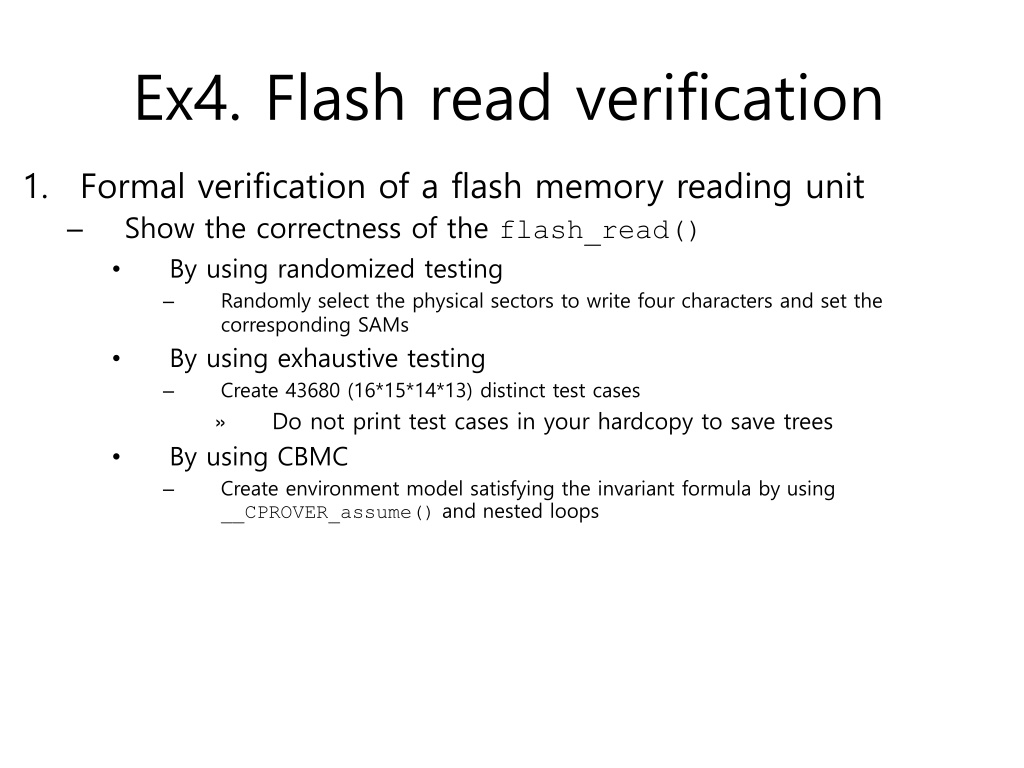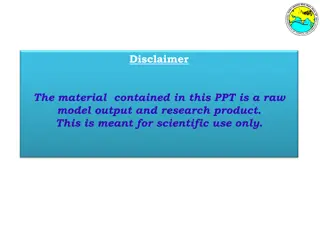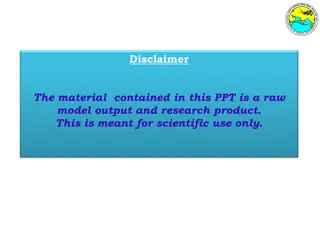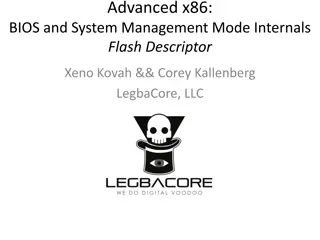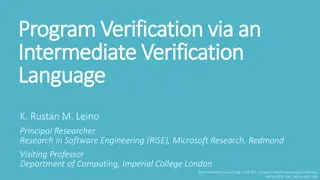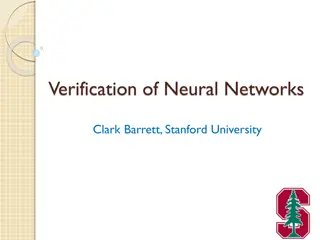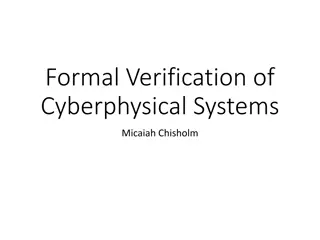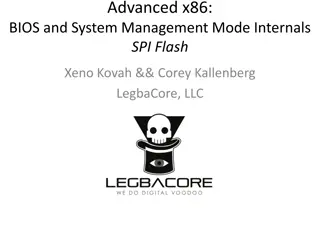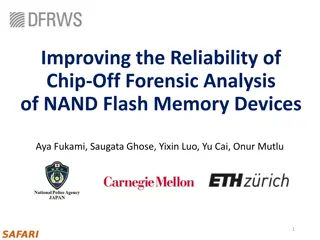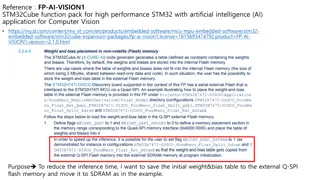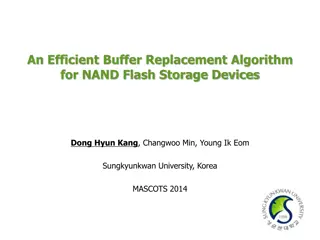Formal Verification of Flash Memory Reading Unit
Perform formal verification of a flash memory reading unit by demonstrating correctness using randomized testing and exhaustive testing. Randomly select physical sectors to write characters and set corresponding Security Assertion Markup (SAM) structures. Create a total of 43,680 distinct test cases without printing them to save trees. Utilize CBMC to create an environment model satisfying the invariant formula by utilizing __CPROVER_assume() and nested loops.
Download Presentation

Please find below an Image/Link to download the presentation.
The content on the website is provided AS IS for your information and personal use only. It may not be sold, licensed, or shared on other websites without obtaining consent from the author. Download presentation by click this link. If you encounter any issues during the download, it is possible that the publisher has removed the file from their server.
E N D
Presentation Transcript
Ex4. Flash read verification 1. Formal verification of a flash memory reading unit Show the correctness of the flash_read() By using randomized testing Randomly select the physical sectors to write four characters and set the corresponding SAMs By using exhaustive testing Create 43680 (16*15*14*13) distinct test cases Do not print test cases in your hardcopy to save trees By using CBMC Create environment model satisfying the invariant formula by using __CPROVER_assume() and nested loops
typedef struct _SAM_type{ unsigned char offset[SECT_PER_U]; }SAM_type; typedef struct _PU_type{ unsigned char sect[SECT_PER_U]; }PU_type; // Environment assumption // 0. Each unit contains 4 sectors. // 1. There is one logical unit containing "abcd" // 2. There are 4 physical units // 3. The value of SAM table is 255 if the corresponding // physical sector does not have a valid data void flash_read(char *buf, SAM_type *SAM, PU_type *pu ){ unsigned char nSamIdx = 0; unsigned char pu_id = 0; unsigned char n_scts = 4; // number of sectors to read unsigned char offset = 0; //offset of the physical sector to read unsigned char pBuf = 0; while(n_scts > 0){ pu_id=0; offset = 255; // read 1 character while(1) { if (SAM[pu_id].offset[nSamIdx] != 255){ offset = SAM[pu_id].offset[nSamIdx++]; buf[pBuf] = PU[pu_id].sect[offset]; break; } pu_id ++; } n_scts--; pBuf ++; } }
#include <stdio.h> #include <time.h> #include <assert.h> #define SECT_PER_U 4 #define NUM_PHI_U 4 Problem #1. Random solution typedef struct _SAM_type{ unsigned char offset[SECT_PER_U]; SAM_type; void main(){ char res[50]; int tc = 0; int count = 0; int nTC = 43680;// # of possible distribution // 16*15*14*13 while(tc++ < nTC){ randomized_test(); flash_read(&res[count],SAM,pu); assert(res[0] == 'a' && res[1] == 'b' && res[2] == 'c' && res[3] =='d'); }} typedef struct _PU_type{ unsigned char sect[SECT_PER_U]; }PU_type; char data[SECT_PER_U] = "abcd"; PU_type pu[NUM_PHI_U]; SAM_type SAM[NUM_PHI_U]; void randomized_test(){ unsigned int i = 0, j = 0; unsigned char ind_pu, ind_Sect; // Initialization for(i = 0;i < NUM_PHI_U;i++){ for(j = 0;j < SECT_PER_U;j++){ SAM[i].offset[j] = 255; pu[i].sect[j] = 0; }} ind_pu 0 1 2 3 ind_sect 0 while (i< SECT_PER_U) { ind_pu = rand()%4; ind_Sect= rand()%4; if(pu[ind_pu].sect[ind_Sect] == 0){ pu[ind_pu].sect[ind_Sect] = data[i]; SAM[ind_pu].offset[i] = ind_Sect; i++; } } 1 2 3 }
ind_pu 0 1 2 3 Problem #1. Exhaustive solution a 0 ind_sect b 1 data_pos c d 2 0 5 10 11 3 void main(){ char res[4]; int i, j,k,l, data_pos[4]; //# of all distributions = 16*15*14*13 for(i = 0;i < NUM_PHI_U * SECT_PER_U;i++){ for(j = 0;j < NUM_PHI_U * SECT_PER_U;j++){ if (j == i) continue; for(k = 0;k < NUM_PHI_U * SECT_PER_U;k++){ if (k == i || k == j) continue; for(l = 0;l < NUM_PHI_U * SECT_PER_U;l++){ if(l == i || l == j || l == k) continue; void exhaustive_test(int *data_pos){ unsigned int i = 0, j = 0; unsigned char ind_pu, ind_Sect; for(i = 0;i < NUM_PHI_U;i++){ for(j = 0;j < SECT_PER_U;j++){ SAM[i].offset[j] = 255; pu[i].sect[j] = 0; } } for(i = 0;i < for(i = 0;i < NUM_PHI_U;i NUM_PHI_U;i++){ ind_pu ind_pu = = data_pos data_pos[i]/4; ind_Sect ind_Sect = = data_pos data_pos[i]%4; pu pu[ [ind_pu ind_pu].sect[ ].sect[ind_Sect SAM[ SAM[ind_pu ind_pu].offset[i] = } } ++){ data_pos data_pos[0] = i; data_pos data_pos[1] = j; data_pos data_pos[2] = k; data_pos data_pos[3] = l; exhaustive_test exhaustive_test( (data_pos flash_read flash_read(&res[count], (&res[count],SAM,pu assert(res[0] == 'a' && res[1] == 'b' assert(res[0] == 'a' && res[1] == 'b' && res[2] == 'c' && res[3] == 'd'); && res[2] == 'c' && res[3] == 'd'); [0] = i; [1] = j; [2] = k; [3] = l; [i]/4; [i]%4; ind_Sect] = data[i]; ] = data[i]; ].offset[i] = ind_Sect ind_Sect; ; data_pos); ); SAM,pu); ); } } } } } }
Problem #1. CBMC solution void CBMC_environ_setting(){ unsigned int i = 0, j = 0; unsigned char ind_pu, ind_Sect; for(i = 0;i < NUM_PHI_U;i++){ for(j = 0;j < SECT_PER_U;j++){ SAM[i].offset[j] = 255; pu[i].sect[j] = 0; }} Execution time(sec) 0.45 0.4 0.35 0.3 0.25 0.2 0.15 0.1 0.05 0 Randomize Exhaustive CBMC for(i = 0;i < SECT_PER_U;i++){ ind_pu = nondet_char(); ind_Sect = nondet_char(); __CPROVER_assume(ind_pu>=0 && ind_pu <NUM_PHI_U); __CPROVER_assume(ind_Sect>=0 && ind_Sect <SECT_PER_U); __CPROVER_assume(pu[ind_pu].sect[ind_Sect] == 0); Execution time(sec) pu[ind_pu].sect[ind_Sect] = data[i]; SAM[ind_pu].offset[i] = ind_Sect; } } void main(){ char res[50]; int count = 0; CBMC_environ_setting(); flash_read(&res[count],SAM,pu); assert(res[0] == 'a' && res[1] == 'b' && res[2] == 'c' && res[3] == 'd'); assert(res[0] == 'a' && res[1] == 'b' && res[2] == 'c' && res[3] == 'd');}
